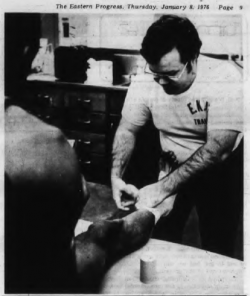History of Athletic Training at EKU: Part 3 - From Graduate to Full-Time Athletic Trainers
At this time, athletic training at EKU began to develop quickly. The University of Kentucky and other SEC schools had already established full-time athletic training positions. And though it wasn’t common practice in the OVC, Murray State led the charge by hiring the first full-time AT in the conference. It was time for EKU to make that same step and so, a position was posted leading to EKU’s first full-time athletic trainer, David Huffstettler.
Unfortunately, at the time of this report, not much information could be found on Mr. Huffstettler other than that his tenure was relatively short. He worked at EKU from the summer/fall of 1965 for 4 years and was followed by Ken Murray in 1969. After leaving EKU, David Huffstettler would work at Baylor University, the University of South Carolina, and the University of Toledo. While at the University of South Carolina, he would work for coach Paul Dietzel who would later become commissioner of the Ohio Valley Conference in which EKU is a member. Coach Dietzel would work to establish athletic training staffs at all OVC institutions while acting as commissioner.
When Ken Murray was hired in 1969, he came to EKU with experience ranging from the high school to the professional sports setting.1 He began just as the current Roy Kidd Stadium was being completed. His athletic training facility was across campus in the original athletic training facility within the Weaver Physical Education Building but games in that fall were played on the new field. As he was starting his career at EKU, changes within the profession and the creation of certification were just occurring. He became certified and may have been the first certified AT at EKU. His certification number was D9-41, marking him as the 41st certified AT in the Southeast Athletic Trainers’ Association.
At this time, the full-time position looked different than today’s athletic trainers at EKU. Ken started with a 9-month contract with a limited salary. As such, during the summer, he sought employment in other capacities. It wasn’t uncommon to see a coach or athletic trainer working with maintenance staff during the summer months or filling another important position at the University. Despite these different roles throughout the summer months, he was able to start a series of summer camps and workshops that could run from 1 day up to 1-2 weeks. One series called the “Seminar in Medical Aspects” had a similar look to current conferences with topics titled: “To Tape or Not To Tape”, “Women’s Medical Problems in Sports”, “Ergogenic Aids In Sport”, “Artificial Turf”, “Head Injuries” and “Heat Illness and Nutrition of Athletes”.2 Students interested in learning skills of the profession and gaining experience could come on campus and listen to presentations and practice skills. During these camps, he provided many opportunities to women who were just coming into the profession.
In addition to the summer employment differences, the responsibilities were also different in-season. Athletic trainers today continue to focus on the prevention, evaluation, acute care, management and rehabilitation of injuries like early athletic trainers. However, athletic trainers in these early years often took on additional responsibilities. In the words of Ken Murray, “if it needed to be done, you did it”. These additional responsibilities often included managing the logistics of travel (hotel, food, etc) and assisting with other business aspects of sport.
Ken remained at EKU until 1976 and during his tenure he created a lot of “first-time” opportunities. He was the first to hire certified graduate assistant athletic trainers and the first full-time female athletic trainer at EKU, Darcy Shariver. He became the first tenured AT faculty on campus, who also worked with sports covering football, baseball, track and basketball. Lastly, he was part of the team to work on the creation of EKU’s first athletic training curriculum. This curriculum was developed with another faculty member, Dr. Paul Motley, who taught physical education courses and was connected to EKU’s Athletic Training program as the student aide working with Chris Patrick, EKU’s first Graduate Assistant, Head Athletic Trainer.
Though briefly mentioned previously, it is important to reiterate that though full-time athletic trainers were starting to be hired to provide medical coverage at EKU, graduate student involvement still remained an essential component to the medical care provided to student athletes. With the advent of certification, certified graduate students were hired to provide coverage while completing a Master’s degree. These students continued gaining professional experience under the guidance of staff athletic trainers and have continued working in a variety of settings and professional leadership positions, receiving numerous accolades in their professional journeys.
In 1976, Mr. Murray transitioned to another institution and left the position to perhaps the longest employed AT at EKU and arguably one of the most well-known, Dr. Bobby Barton.
References:
1Murray, K. (2017). Interview, Oral Communication.
2Myers, T. (1972). Personal Communication to President Robert Martin.
Contact Information
Matthew J Sabin
matthew.sabin@eku.edu
859.622.8149
Published on June 11, 2018
